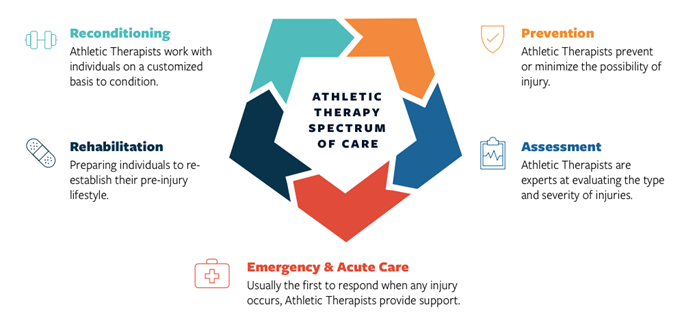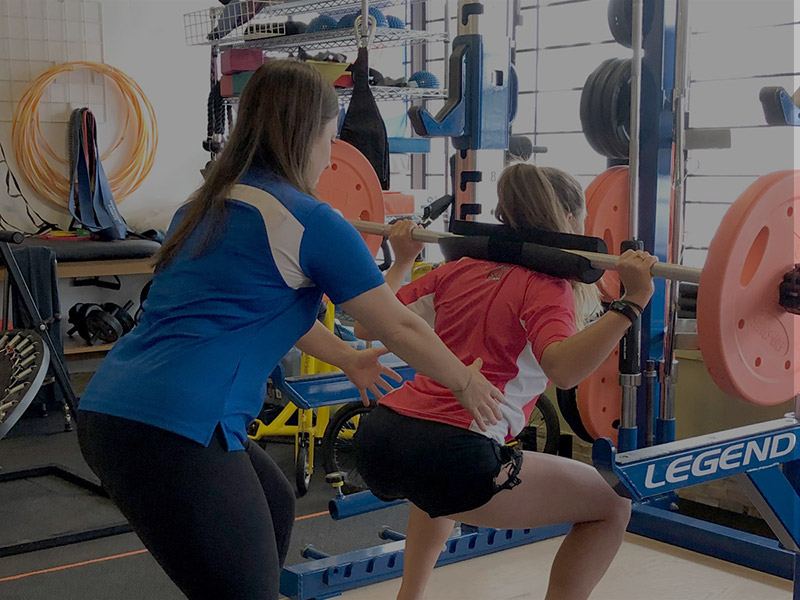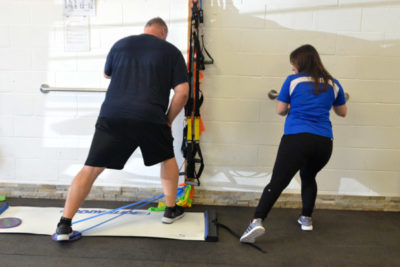
June is Athletic Therapy Month
Athletic Therapist’s adhere to the sports medicine model of care. They treat a wide range of patients, from kids with concussions to seniors recovering from hip replacement surgery, using various manual therapies, modalities, exercise prescription and even bracing and taping.
What is Athletic Therapy?
Athletic Therapy is a profession that specializes in the prevention and care of musculoskeletal injuries that involve muscles, joints and bones. Athletic Therapists also specialize in emergency care as it relates to on field injuries and emergencies during sporting events.
“Athletic Therapist adhere to the sports medicine model of care. They treat a wide range of patients, from kids with concussions to seniors recovering from hip replacement surgery, using various manual therapies, modalities, exercise prescription and even bracing and taping.
The treatment varies but the objective doesn’t:
an Athletic Therapist’s goal is to help clients return to their usual activities, whether that means playing competitive sports or walking to the mailbox” (1)


Education and Certification
Individuals will have attended an Athletic Therapy program at 1 of 8 accredited institutions in Canada earning a Bachelor’s degree, including 1200 hours of field and clinical practical training. Upon graduation and successful completion of the National Certification Exam, an Athletic Therapist is granted the credentials of Certified Athletic Therapist. They can be recognized with the letters CAT(C) after their name.
Scope of Practice
“The scope of practice of a Certified Athletic Therapist starts with the in-depth knowledge, education and training in the areas of the human musculoskeletal system, exercise physiology, biomechanics and basic emergency care. Within this, the scope of practice is divided into five practice domains representing the core areas of competency…” (1)
- Prevention
- Assessment
- Intervention
- Practice Management
- Professional Responsibility

What type of injuries/conditions can they treat?
Athletic Therapists can treat a variety of injuries, from chronic pain that has been nagging you for longer than you can remember to freshly sprained ankles. Some common injures/conditions include:
- Muscle Strains or Tears
- Low Back Pain
- Joint Dysfunctions
- Sciatica
- Disc Herniations
- Pre/Post Surgical Rehabilitation
- Osteoarthritis
- Postural Dysfunctions
- Gait Retraining
- Concussions



Where do Athletic Therapists work?
Athletic Therapists can be found in a number of different venues. You will see them running onto the playing surface of a sporting event when an athlete gets injured, they can be found in a gym taking a client through a rehabilitation or a strength and conditioning program, in a multidisciplinary clinic working as a primary care provider or assisting another healthcare professional, in retirement homes, hospitals or any other venue that requires the knowledge and skill set of an Athletic Therapist. Our objective is to return clients to their usual activities of everyday life. “Whatever your finish line”

Videos
FAQ’s
Do I need a referral from my Doctor to see an Athletic Therapist?
No, you do not need a referral from your Doctor, however if you plan on claiming your treatments through your insurance provider you may need one. Check with your specific policy first.
Does my insurance cover Athletic Therapy?
Athletic Therapy is covered by a number of insurance companies, but it is always best to check with your specific provider first. Below are a few companies in Ontario that provide coverage for Athletic Therapy:
- Great West Life
- Blue Cross
- Desjardin
- Greenshield
- Manulife
- Hockey Canada
- Claim Secure
- Standard Life
- Empire Life
What is the difference between a Physiotherapist (physio) and an Athletic Therapist (AT)
Both treat musculoskeletal injuries, but they differ in their professional designations, education and scope of practice. The scope of practice is one of the main differences between a physiotherapist and an Athletic Therapist. A physio typically has a wider scope of practice than an AT. Where an AT focuses on injuries as they relate to the muscles, bones and joints of the body; physios are also trained in cardio-respiratory rehab, burn rehab, pediatrics, stroke and neurological rehabilitation. Both professions participate in continuing education courses post-graduation expanding their knowledge and skill set. Areas of interest and specialities may help you in deciding who is best fit to treat your specific injury.
References
https://athletictherapy.org/en
https://www.ontarioathletictherapists.com
https://yourfinishlineathletictherapy.ca
Author:
Kristen Sarlo CAT(C)
Athletic Therapist
Registered Kinesiologist